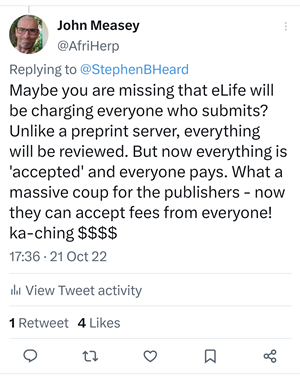Brave New worlds need brave new people
When eLife announced that they were going to publish every article that was reviewed, I reacted like some others in simply focusing on the monetary gain that that may imply.

This may just have been a general cynical reaction to profiteering by publishers in general. At the time I had not realised that eLife is a not for profit organisation. This was mostly because of their APC which was 3,000 USD (now reduced to 2000 USD). As we know (see here) it is hard to justify such an enormous APC. I would welcome eLife to explain in detail why it is that they cannot reduce their APC to something more reasonable. A diamond open access eLife being the model that we would all want to see.
But the attempt at an experiment to change the way in which researchers publish, this is actually very welcome and I applaud eLife and the editors that support this change. The concept that we as readers should be able, and indeed have to, to look at not only the article but also the reviews is very important. It is part of the critical reading that we should be engaged in anytime we read a scientific article and make a decision based on the value therein. At its heart, this model is an attempt to remove the idea of prestige from a journal title.
So is the removal of prestige the reason why there's been such a terrible kickback?
I have made the comment before that the people who really benefit from the current system which is heavy on prestige are the gatekeepers who have obtained and maintained their positions based on this prestige (see here). I was very interested then to read that eLife editor Mike Eisen agrees that this could be the reason for the kickback.
“...opposition to eLife’s model is driven fundamentally by powerful scientists not wanting to change a system that has benefited them and which they have sculpted to continue to reward them”.Michael Eisen in Nature: News Feature
I think that Eisen is right. The reason why these prestigious editors do not want eLife to change its model is because they are only interested in the prestige that they gain by being associated with its title if it continues to be prestigious. This is one of the reasons why we need to change the current publishing system: albeit a wicked problem with many facets that require change (see here).
Perhaps a mistake that eLife has made has been to try to make these changes from the top end of publishing. We saw the same attempt with Public Library of Science (PLoS), who started with high-end journals ls and then initiated PLoS-ONE - eventually leading to serious struggles for their own survival (see here). Getting funders to consider new publishing models appears to necessitate starting at the top, otherwise they take no notice.
"Following its initial success in establishing itself as an open access publisher of high-quality science…"eLife’s Board of Directors
Would Nature News Feature have written an article about change in editorial policy at a low impact factor diamond open access journal? I think not. The reason why this is big news is because big decisions are made around the funding of prestigious work. Threaten to take away that prestige and those who have benefited from it may well get upset. In this case they called for the axing of Eisen as editor. eLife is backed by some powerful funders, so it'll be interesting to watch their reaction as eLife pursues this new publishing model.
This is a multi-layered argument but it's an important one for science. Do you think science would benefit from a world without an accept / reject decision?
Further Reading
Measey J (2022) How to publish in Biological Sciences: a guide for the uninitiated. CRC Press, Boca Raton. ISBN: 9781032116419 https://doi.org/10.1201/9781003220886
To Read Open Access version: www.howtopublishscience.org
